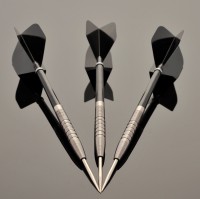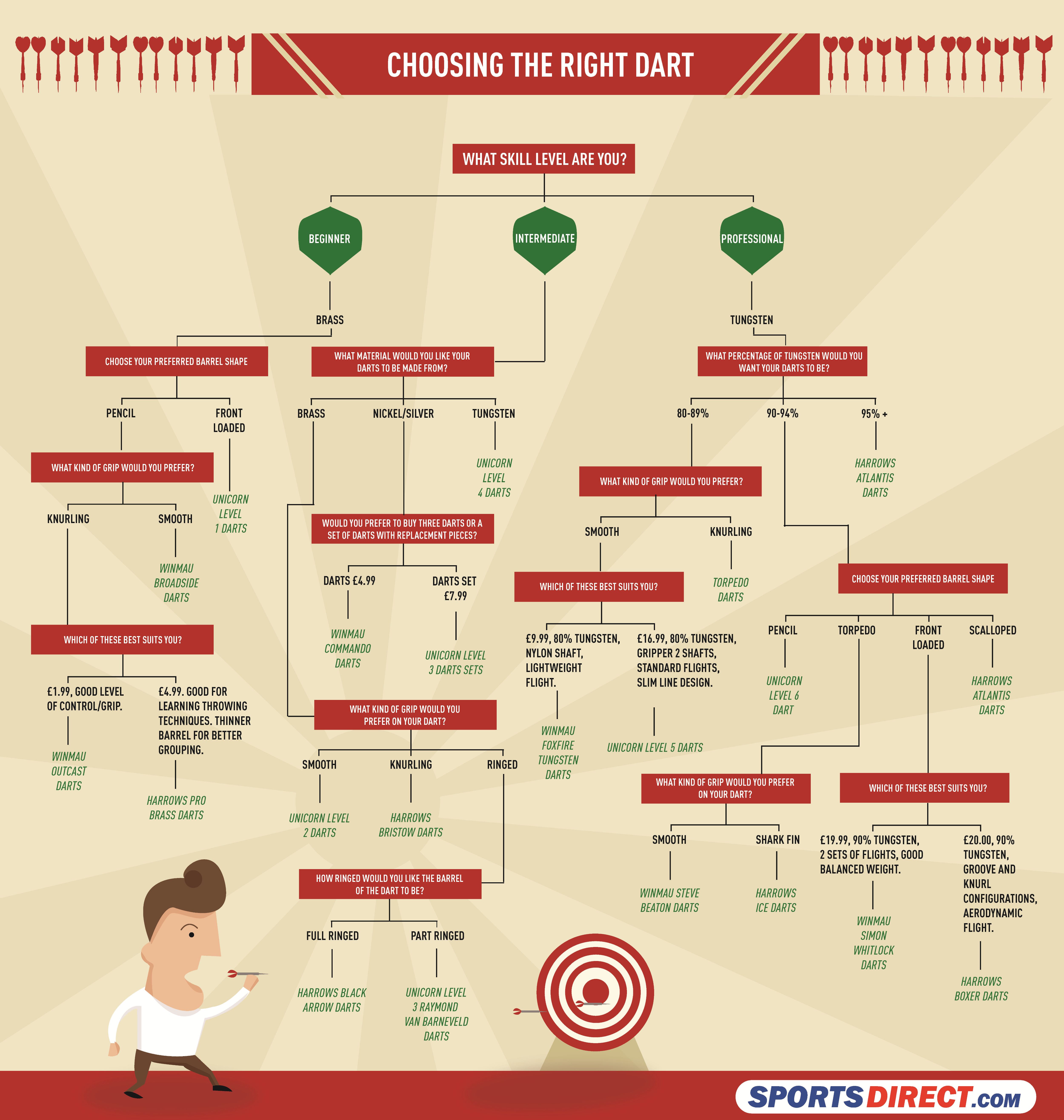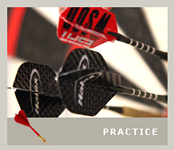
Which dart is right for you? Brass v Nickel v Tungsten
Posted: 07.08.13 in Darts Performance Centre Blog category
Guest blogger Adam Dawson is on a graduate programme with sports retailer Sports Direct!
Darts come in a variety of materials, weights and grips; here I will talk about the different materials used in the production of darts, particularly the main three metals used: brass, nickel and tungsten. Darts will generally consist of a set of three dart barrels, points, shafts and flights which help to stabilise the flight of the dart when thrown; although it is the material of the barrel that is concerned here.
Brass
Brass darts are the most commonly seen types of darts because the inexpensive metal makes them popular in pubs, taverns and at home. Darts made of brass are usually aimed at beginners and are of low cost, therefore making brass a good choice for darts players who have either rarely or even never played darts before. Brass is a softer and less expensive metal than either nickel or tungsten and the drawbacks that come with this include any knurling on the brass grip has the potential to wear down quickly; as well as brass darts having a thicker barrel, because of the lighter metal, which can increase the number of bounce-outs and makes close grouping more difficult.
Nickel
Nickel darts are similarly inexpensive, although do generally cost a small amount more than brass. Darts made of nickel are usually the best choice for beginners who plan on playing relatively frequently because they are made of a harder metal and are therefore more durable than brass because the grip will not wear away as easily.
Tungsten
Tungsten is an extremely dense metal, considerably more so than brass or nickel; this increased density allows more weight in a smaller (thinner) barrel, making close grouping easier while maintaining the weight and minimising bounce-outs. These high-density tungsten darts resist wear far better than brass or nickel. Tungsten darts are recommended for all darts players who have played competitively at some point and are the darts used by all professionals because having all of the darts mass concentrated into such a small, thin area vastly enhances the control of the dart. When buying tungsten darts, it is important to pay attention to the percentage of tungsten in the dart barrels because it is central to the quality of the dart; in general the higher the percentage the better, and more expensive, the dart.
To find the right dart for you, it would be a good start to analyse yourself and your skill level; for example, if you are a beginner and you have never, or very rarely, played darts before, then brass is probably the right dart for you. If you have occasionally played darts before, although no more than socially, then nickel darts would probably suit you best. If at any point you have played darts competitively before, or play it quite frequently and are looking to improve your game, then you should look to buy tungsten darts with a higher percentage of tungsten depending on how many competitive games you have played or plan to play.
This guide should help you with following and answering the questions to the flowchart below:

Post by Category
Posts by Month
- November 2025
- October 2025
- September 2025
- August 2025
- July 2025
- June 2025
- May 2025
- April 2025
- March 2025
- February 2025
- January 2025
- December 2024
- December 2024
- November 2024
- October 2024
- September 2024
- August 2024
- July 2024
- June 2024
- May 2024
- April 2024
- March 2024
- February 2024
- January 2024
- December 2023
- December 2023
- November 2023
- October 2023
- September 2023
- August 2023
- July 2023
- June 2023
- May 2023
- April 2023
- March 2023
- February 2023
- January 2023
- December 2022
- December 2022
- November 2022
- October 2022
- September 2022
- August 2022
- July 2022
- June 2022
- May 2022
- April 2022
- March 2022
- February 2022
- January 2022
- December 2021
- December 2021
- November 2021
- October 2021
- September 2021
- August 2021
- July 2021
- June 2021
- May 2021
- April 2021
- March 2021
- February 2021
- January 2021
- December 2020
- December 2020
- November 2020
- October 2020
- September 2020
- August 2020
- July 2020
- June 2020
- May 2020
- April 2020
- March 2020
- February 2020
- January 2020
- December 2019
- December 2019
- November 2019
- October 2019
- September 2019
- August 2019
- July 2019
- June 2019
- May 2019
- April 2019
- March 2019
- February 2019
- January 2019
- December 2018
- December 2018
- November 2018
- October 2018
- September 2018
- August 2018
- July 2018
- June 2018
- May 2018
- April 2018
- March 2018
- February 2018
- January 2018
- December 2017
- December 2017
- November 2017
- October 2017
- September 2017
- August 2017
- July 2017
- June 2017
- May 2017
- April 2017
- March 2017
- February 2017
- January 2017
- December 2016
- December 2016
- November 2016
- October 2016
- September 2016
- August 2016
- July 2016
- June 2016
- May 2016
- April 2016
- March 2016
- February 2016
- January 2016
- December 2015
- December 2015
- November 2015
- October 2015
- September 2015
- August 2015
- July 2015
- June 2015
- May 2015
- April 2015
- March 2015
- February 2015
- January 2015
- December 2014
- December 2014
- November 2014
- October 2014
- September 2014
- August 2014
- July 2014
- June 2014
- May 2014
- April 2014
- March 2014
- February 2014
- January 2014
- December 2013
- December 2013
- November 2013
- October 2013
- September 2013
- August 2013
- July 2013
- June 2013
- May 2013
- April 2013
- March 2013
- February 2013
- January 2013
- December 2012
- December 2012
- November 2012
- October 2012
- September 2012
- August 2012
- July 2012
- June 2012
- May 2012
- April 2012
- March 2012
- February 2012
- January 2012
- December 2011
- December 2011
- November 2011
- October 2011
- September 2011
- August 2011
- July 2011
- June 2011
- May 2011
- April 2011
- March 2011
- February 2011
- January 2011
- December 2010
- December 2010
- November 2010
Main Index






.jpg)
